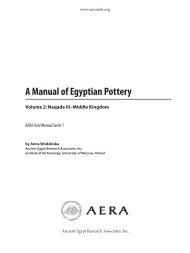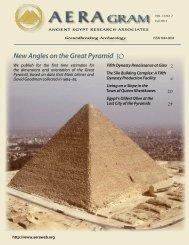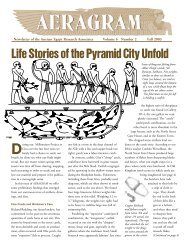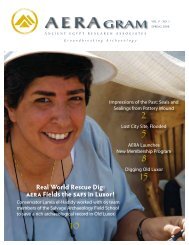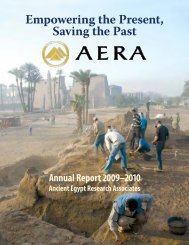The Khentkawes Town (KKT) - Ancient Egypt Research Associates
The Khentkawes Town (KKT) - Ancient Egypt Research Associates
The Khentkawes Town (KKT) - Ancient Egypt Research Associates
Create successful ePaper yourself
Turn your PDF publications into a flip-book with our unique Google optimized e-Paper software.
www.aeraweb.org<br />
A B C D E F G H I J<br />
K L<br />
M<br />
Figure 4. Letter designations for houses in <strong>KKT</strong>. Pieter Collet and Lisa Yeomans recorded the shaded area in 2007. In 2008<br />
Collet worked in a 10 m-wide zone that took in the eastern half of House F and the western half of House G (Fig. 5a).<br />
Team and Schedule<br />
<strong>The</strong> <strong>KKT</strong> 2008 team included: Noha Bulbul (SCA), Pieter<br />
Collet, Delphine Driaux, Amelia Fairman, Mike House,<br />
Daniel Jones, Mark Lehner, Andrea Nevistic, Kasia<br />
Olchowska, Ana Tavares, Amanda Watts, Kelly Wilcox<br />
and Hassan Mohammed Ramadan (SCA trainee). Gaber<br />
Abdel Dayem and Nagla Hafez served as inspectors for the<br />
Supreme Council of Antiquities (SCA). <strong>The</strong> remote sensing<br />
team included Glen and Joan Dash. Jessica Kaiser, Johnny<br />
Karlsson, Afaf Wahba (SCA), Ahmed Gabr (SCA), Amanda<br />
Agnew, Brianne Daniels, and Sandra Koch made up the<br />
osteoarchaeological team who excavated Late Period<br />
human burials.<br />
We began our recording and partial excavation<br />
on Saturday March 1. We completed backfilling on<br />
Wednesday, April 24, 2008.<br />
Recording and Mapping<br />
• Survey: We prepared a contour map of the entire<br />
site that takes in the <strong>KKT</strong> and the Menkaure Valley<br />
Temple (GIII.VT) (fig. 3).<br />
• Geophysical Survey: <strong>The</strong> remote sensing team<br />
prospected the entire area of the GIII.VT and the<br />
high mound of quarry debris between the GIII.VT<br />
and the leg of the <strong>KKT</strong>. <strong>The</strong>y located the corners and<br />
other features of the GIII.VT excavated by Reisner in<br />
1908–1910.<br />
• <strong>KKT</strong> and GIII.VT Mapping: Our mapping is a<br />
complete archaeological recording, including maps<br />
at a large scale, 1:20, and sections and elevation<br />
drawings at 1:10. We expose and record what<br />
is left of the <strong>KKT</strong> in 10 × 10 m square areas. We<br />
document each exposure with photographs and<br />
assign stratigraphic feature numbers to every wall,<br />
deposit, and to cuts, such as pits and trenches. We<br />
complete an information form for each feature<br />
so designated. Whenever relevant, we excavate<br />
specific features either to clarify stratigraphic<br />
relationships or to collect archaeobotanical<br />
samples, pottery for dating, and any remaining<br />
material culture.<br />
Excavations<br />
We selected three main areas for excavation (Color Plate 1):<br />
• Area <strong>KKT</strong>-AI: <strong>The</strong> Interface: We called this area,<br />
<strong>KKT</strong>-AI, “Amelia’s Interface,” after Amelia Fairman,<br />
who supervised work here. <strong>The</strong> boundaries of<br />
the Interface took in the road, or “Ramp,” leading<br />
east immediately south of the <strong>KKT</strong> settlement and<br />
north of the GIII.VT; the northern end of the Antetown<br />
that Selim Hassan found attached to the<br />
eastern front of the GIII.VT; the northeast corner<br />
of the GIII.VT; and the southern end of the <strong>KKT</strong>-F,<br />
the “foot” of the town. A massive, thick eastern<br />
12<br />
Giza Plateau Mapping Project Season 2008 Preliminary Report





